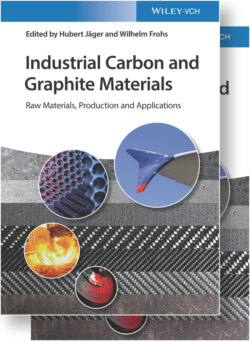Читать книгу Industrial Carbon and Graphite Materials - Группа авторов - Страница 307
6.1.3 Calcination
ОглавлениеCalcination is performed as follows. Raw coke cut out from the coke drum contains 5–10% VM, which is eliminated by calcination. A calciner includes a retort calciner, a shaft kiln calciner, a rotary kiln calciner, and a rotary hearth calciner, but the rotary kiln calciner is generally used. The use of the rotary kiln calciner will be described as follows. A flow chart of the process using the rotary kiln calciner is illustrated in Figure 6.1.3.2. Major equipment includes a conveyor for charging raw coke, a rotary kiln, a rotary cooler, a belt conveyor, a sieving machine, and a coke silo. The calcination temperature ranges generally from 1100 to 1500 °C. What happens in each temperature zone is summarized in Table 6.1.3.5 [18]. Up to 150 °C, water (7–12%) contained in raw coke is removed by drying. Raw coke is next heated to approximately 800°C to induce the evaporation of VM and the decomposition of hydrocarbons (generation of methane and hydrogen gases) in raw coke. In this step large shrinkage of coke occurs. In the calcination process to 800–1400 °C dehydrogenation and oxidation of coke occur, and the content of hydrogen in coke is reduced to 0.05% before reaching to 1400 °C. A yield in calcination is widely varied with the operational condition and the VM in raw coke but is generally approximately 80%. Calcination causes rapid densification of the carbon structure to increase the RD to 2.00–2.14. The X‐ray diffraction analysis indicates that the average crystal thickness, Lc, is increased in the vicinity of approximately 900 °C and crystal growth can be observed [19] (Figure 6.1.3.4). Particularly when needle coke is used in the aggregate of a synthetic graphite electrode, the calcination temperature in a calciner is set in a range of 1300–1450 °C, but fluctuation of the calcination temperature is preferably minimized since the amount of a pitch binder required in production of the synthetic graphite electrode is affected by the operation temperature. Excessive calcination gives the adverse effects to the production of the synthetic graphite electrode.
Table 6.1.3.5 Changes in calcination.
Source: Kurami 1973 [18]. Reproduced with permission of Wolters kluwer.
| Step | Temperature (°C) | Phenomenon |
|---|---|---|
| 1 | Ambient temperature to 150 | Drying |
| 2 | 150–480 | Evaporation of volatile matter |
| 3 | 480–760 | Thermal decomposition and shrinkage |
| 4 | 760–1370 | Dehydrogenation reaction and crystallization of coke |
| 5 | 1370–1530 | Desulfurization reaction |
Figure 6.1.3.4 Changes in calcination ([19] extract). (a) changes of coke crystalline sixe as a function of calcination temperature. (b) changes of thermal expansion coefficient as a function of calcination temperature. (c) changes of coke porosity as a function of calcination temperature.
Important properties required for needle coke used in the synthetic graphite electrode are the coefficient of thermal expansion (CTE) to be low. CTE depends on the structure and shape of coke as a raw material. This property is almost determined in the formation of raw coke and can be little improved by the operation (and its condition) of a calciner.
